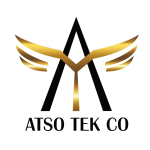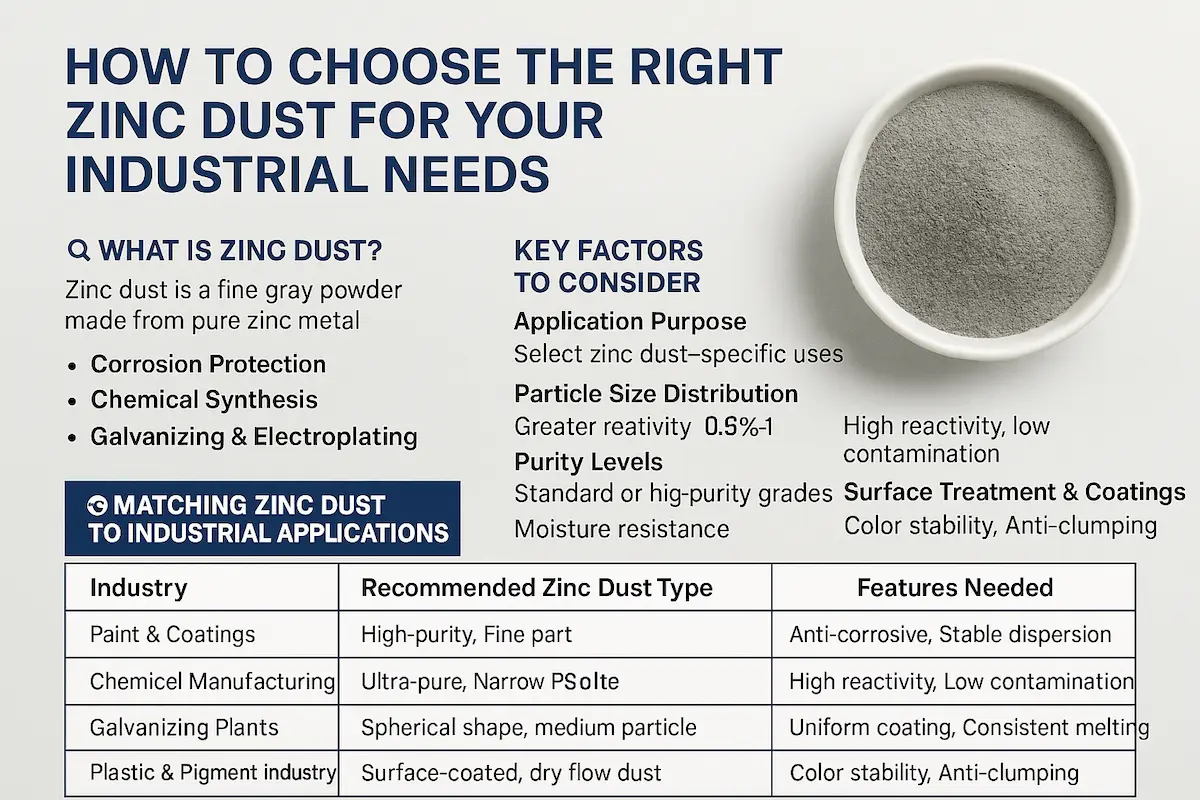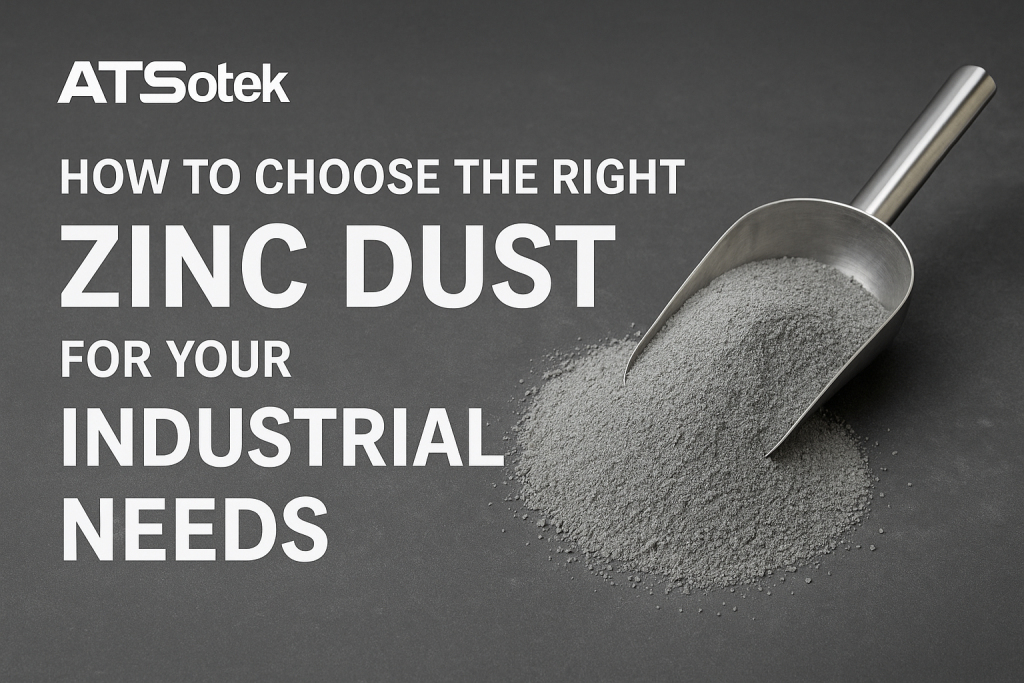Zinc dust is an indispensable material in many heavy industries, especially in corrosion-resistant coatings, chemical manufacturing, and metallurgical processes. Choosing the right type of industrial zinc dust can directly impact your product performance, durability, and even regulatory compliance.
In this comprehensive guide, we’ll explore how to identify the ideal zinc dust type for your specific application, what quality benchmarks to look for, and how global suppliers like ATSotek can ensure consistent quality and support.
What Is Zinc Dust? A Quick Primer
Zinc dust (Zn) is a fine, bluish-grey metallic powder primarily composed of elemental zinc. It’s typically manufactured via:
- Atomization: High-pressure air or gas breaks molten zinc into droplets
- Condensation: Zinc vapor is cooled and collected as fine powder
Zinc dust is different from zinc powder used in cosmetics or supplements—this form is purely industrial and not suitable for human consumption.
Key Applications of Industrial Zinc Dust
| Industry | Application | Purpose |
|---|---|---|
| Paints & Coatings | Zinc-rich primers, marine paints | Cathodic protection from corrosion |
| Chemical Manufacturing | Synthesis, reduction reactions | Reducing agent for diazonium salts, organic synthesis |
| Galvanizing | Zinc-rich slurry in hot-dip galvanization | Metallic coating for rust prevention |
| Battery Industry | Zinc-air and alkaline batteries | High energy-density electrode material |
| Plastics & Pigments | Colorants, UV shielding | Improves durability and color fastness |
Understanding Zinc Dust Grades
Different projects require different zinc dust grades, which are categorized based on:
- Purity (% Zinc)
- Particle Size Distribution (PSD)
- Shape (spherical or irregular)
- Surface Area (BET)
- Flowability / Moisture Content
- Standard Grades (≥98%): Used in paints, coatings, and general-purpose applications. Balances cost with performance.
- High Purity Grades (≥99.5%): Used in chemical synthesis, electronics, and precision galvanizing. Reduces side reactions.
- Surface-Treated Grades: Specially coated or passivated to resist moisture absorption, clumping, or spontaneous oxidation.
Particle Size Matters: D50, D90 and Why It Counts
Zinc dust particles range from a few microns to over 100 µm in size. The smaller and more uniform the particles:
- The better the dispersion in paint or chemical media
- The faster the surface reactivity in reactions
- The smoother the coating finish
Look for detailed PSD charts from your supplier—knowing the D50 (median) and D90 (90% finer than this size) is essential.
Quality Control Considerations
Whether you’re a zinc dust importer or end-user, quality assurance is critical. Your supplier should guarantee:
- ISO 9001:2015 certified production
- Batch-specific COA (Certificate of Analysis)
- Moisture control and anti-agglomeration packaging
- Consistency in metallic zinc content
ATSotek, for example, conducts multi-stage testing—laser diffraction for particle size, XRF for zinc % analysis, and humidity chamber exposure for storage stability.
Compliance and Regulatory Considerations
Working with industrial zinc dust means adhering to strict environmental and safety guidelines. Depending on your region and application, ensure the supplier complies with:
- REACH (Europe)
- RoHS (Electronics industry)
- OSHA & GHS labeling (USA)
- HazMat shipping protocols (IATA/IMO)
Common Mistakes to Avoid When Choosing Zinc Dust
- Assuming “one type fits all” – Always tailor your choice to the process.
- Ignoring packaging specs – Moisture-sensitive zinc dust must be sealed tightly.
- Skipping supplier verification – Always request documentation, testing, and samples.
- Choosing price over performance – Low-cost zinc dust may lead to higher operational failure.
Expert-Approved Selection Checklist
| Criteria | Why It Matters | How to Verify |
|---|---|---|
| Zinc Purity | Impacts performance, conductivity | COA with %Zn (≥98% or ≥99.5%) |
| Particle Size | Affects reactivity and coating uniformity | D50, D90 values via PSD analysis |
| Surface Treatment | Shelf life, anti-clumping | Passivation type on datasheet |
| Supplier Certifications | Ensures traceability & consistency | ISO, REACH, RoHS docs |
| Packaging & Delivery Options | Affects product quality during shipping | HDPE drums, vacuum bags, desiccants |
Why Partner With ATSotek for Zinc Dust Procurement?
ATSotek is not just a supplier — we’re a strategic partner in your supply chain. We support industries in over 20 countries with:
- Custom zinc dust formulations
- Full technical documentation & MSDS
- Private labeling for OEMs
- Fast and secure international shipping
- Dedicated technical advisors for every region
Whether you need bulk zinc dust for coatings or lab-grade zinc powder, we provide flexibility, reliability, and quality assurance.
Frequently Asked Questions (FAQ)
- What’s the difference between zinc dust and zinc powder? While often used interchangeably, zinc dust typically refers to ultra-fine particles used in industrial applications, whereas zinc powder may include coarser or food-grade types.
- Is zinc dust dangerous? Yes, it can be hazardous if inhaled or exposed to moisture (flammability). Proper PPE, ventilation, and storage protocols are essential.
- Can I get a free sample for testing? Yes, ATSotek offers sample kits for qualified buyers—contact our sales team.
- What’s the typical lead time for delivery? Between 5–14 days depending on order volume and location.
Ready to Choose the Right Zinc Dust?
Don’t leave your industrial success to chance. Whether you’re in automotive coatings, battery manufacturing, or chemical synthesis, the right zinc dust makes all the difference.
Contact ATSotek today for a personalized recommendation, datasheet, and quote.




